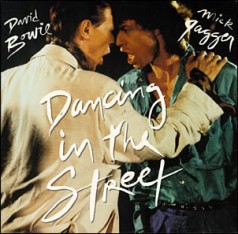 If there was a ranking with the most bizarre 80s music videos, Dancing In The Street by Mick Jagger and David Bowie would surely get a place in the top 5. Having seen this there can be no doubt, where the rumours about an affair between the two famous musicians come from.
If there was a ranking with the most bizarre 80s music videos, Dancing In The Street by Mick Jagger and David Bowie would surely get a place in the top 5. Having seen this there can be no doubt, where the rumours about an affair between the two famous musicians come from.
However, the song has an interesting background story. Dancing In The Street was originally performed by Martha & The Vandellas in 1964. Then in 1985 there was the idea that Bowie and Jagger should perform the song together at Live Aid via satellite link with Bowie singing at Wembley stadium and Jagger on stage in Philadelphia. But soon it turned out that the satellite connection would cause a half-second delay and make the cross-continental live duet impossible unless either Jagger or Bowie mimed their contribution. As neither of them was willing to do that, they buried the original plan and decided to record the song as a charity single instead. They made some slight changes to the lyrics. Their announcement at the beginning “Ok, Tokyo, South American, Australia, France, Germany, UK, Africa” should reflect the international message of charity. The line “Back in the U.S.S.R” is a reference to the Beatles song of the same title.
When Bowie was recording his parts for the Absolute Beginners soundtrack at Abbey Road studios, Jagger flew over to London, too, and they converted some studio time to record Dancing In The Street. The producer Clive Langer told 1000 UK #1 Hits: „We were working on Absolute Beginners with Bowie. We were doing the backing track and David said, ‚Do you mind if we do a charity single tonight?‘ I said, not at all, we’ll help you.”
The recording didn’t take more than four hours. Mick Jagger told the Rolling Stone magazine: „We banged it out in just two takes. It was an interesting exercise in how you can do something without worrying too much.“
Immediately after the recording Bowie and Jagger went straight to the Docklands to film a video for the song with director David Mallet. And 13 hours after Jagger had entered the studio to record the song, the infamous video was finished, too. Maliciously you could say, maybe they should have taken some more time. Cheesy dance moves, strange performance and silly clothes – but hey, it was the 80s and it’s great fun to watch.
Fun Facts
- In a survey the song was voted as the top song British people would play at street parties on the occasion of the Royal Wedding of William and Kate.
- At the end of a Family Guy episode the video is played in its entire length followed by Peter Griffin speaking the words: „That happened. And we all let it happen.“ (watch on youtube)
See also
- Read a funny scene by scene analysis of the video on grantland.com:
Rembert explains the ’80s: David Bowie and Mick Jagger „Dancing in the Street“




